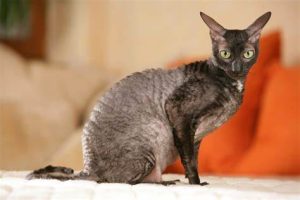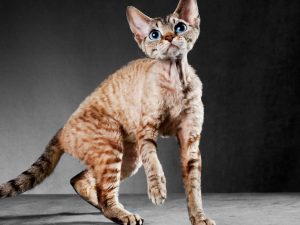Basic information about Cornish Rex Cats
The Cornish Rex is a distinctive and beloved cat breed known for its unique appearance, elegant physique, and affectionate personality. Here’s an overview of Cornish Rex cats:
Appearance
This breed has a slender and graceful body with long, slender legs and a svelte, arched back. They are medium-sized cats with a lithe and athletic build, characterized by their distinctive curly coat and large, expressive eyes.
Their head is egg-shaped, with high cheekbones and large, upright ears that give them an alert and attentive expression. These cats have a long, elegant neck and a tapered muzzle, contributing to their overall sleek and refined appearance.
The most notable feature of This breed is its curly coat, which is short, soft, and wavy. The coat lies close to the body and lacks the traditional guard hairs found in most cat breeds. It comes in a wide variety of colors and patterns, including solid colors, tabby, and tortoiseshell.
Temperament
These cats are known for their playful, affectionate, and sociable nature. They are intelligent and inquisitive cats that enjoy interacting with their human companions and exploring their surroundings.
They are often described as “clownish” due to their playful antics and mischievous behavior. They love to play games, chase toys, and engage in interactive play with their owners.
Despite their energetic temperament, they cats are also affectionate and enjoy cuddling with their owners. They form strong bonds with their human companions and thrive on attention and affection.

History
This breed originated in Cornwall, England, in the 1950s when a curly-coated kitten named Kallibunker was born in a litter of barn cats. Kallibunker’s unique coat was the result of a spontaneous genetic mutation.
Breeders recognized the potential of Kallibunker’s distinctive appearance and began selectively breeding Cornish Rex cats to perpetuate the trait. They crossed Kallibunker with other cats, including domestic shorthairs and Siamese cats, to establish and stabilize the breed.
The breed quickly gained popularity for its unique appearance and playful personality. It was officially recognized by major cat registries, including The International Cat Association (TICA) and the Cat Fanciers’ Association (CFA), in the 1960s.
Care
These cats have short, low-maintenance coats that require minimal grooming. Occasional brushing helps to remove loose hair and distribute natural oils, keeping the coat healthy and shiny.
Provide a balanced and nutritious diet appropriate for your Cornish Rex’s age, weight, and activity level. Ensure access to fresh water at all times, and monitor their food intake to prevent obesity.
Keep your beloved pet mentally and physically stimulated with interactive toys, puzzle feeders, and play sessions. They enjoy climbing, exploring, and engaging in activities that challenge their agile minds and bodies.
Schedule regular veterinary check-ups to monitor your cat’s health and address any potential issues early on. Keep up with vaccinations, parasite prevention, dental care, and routine blood work as recommended by your veterinarian.
Difference between Cornish Rex and Devon Rex cats
Coat Texture
- Cornish Rex: The Cornish Rex has a short, soft, and wavy coat that lies close to the body. The coat lacks the traditional guard hairs found in most cat breeds, resulting in a soft and velvety texture.
- Devon Rex: The Devon Rex also has a short, soft, and curly coat, but it tends to be finer and more delicate than that of the Cornish Rex. The coat may have tighter curls and a more crimped appearance, giving it a slightly different texture.
Body Type
- Cornish Rex: The Cornish Rex has a slender and graceful body with long, slender legs, an arched back, and a sleek, elegant silhouette.
- Devon Rex: The Devon Rex also has a slender body, but it may appear more compact and muscular than that of the Cornish Rex. They have a rounded chest, broad shoulders, and a slightly more robust build.
Head Shape
- Cornish Rex: The head of a Cornish Rex is egg-shaped, with high cheekbones, large, upright ears, and a tapered muzzle. They have a distinctive appearance that is both elegant and refined.
- Devon Rex: The Devon Rex has a more triangular head shape, with large, wide-set ears, prominent cheekbones, and a short, blunt muzzle. Their head shape may appear rounder and more elf-like compared to the Cornish Rex.
Ears
- Cornish Rex: Cornish Rex cats have large, upright ears that are set high on the head. The ears are pointed and may have a slight curve at the tips.
- Devon Rex: Devon Rex cats also have large ears, but they may appear wider at the base and more rounded at the tips. The ears are set slightly lower on the head compared to the Cornish Rex.

More posts you might be interested in:

